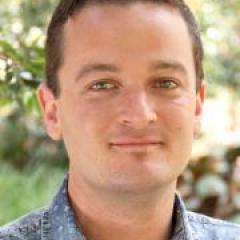Daniel Seed, PhD Candidate in Journalism and News Literacy from UQ is part of the production team on '360 - Minerals, materials and a sustainable future', a panel discussion program which is a collaboration between The University of Queensland and the ABC. It will be recorded at the St Lucia campus on 28 November as part of the UQ's Global Leadership Series.
He reflects on what he's learnt about the intricacies of live production and the challenge of transforming a teaching space into a television studio.
The complexities of live production were one of the biggest challenges in producing the 360 project with UQ and the ABC. Within the production of the program, we were dealing with a monumental number of moving parts and a large part of my role was liaising with the ABC production crew, UQ’s audio-visual and IT services, and the Advanced Engineering Building venue coordinators to bring the program together.
This meant planning the location of cameras and boom operators within the theatre, the placement of the control room to collect footage from the theatre and to send it to the outside broadcast van, security considerations, seating plans for featured speakers within the audience, staffing arrangements for the bump-in and filming, and even choosing the chairs and dry bars to be on stage for the panellists.

Thematically, one of the key moments for the program is in the opening setup package. The challenge was to find the right balance of macro and micro. We needed to establish the big themes of the program - sustainable development, future minerals needs, environmental and climate concerns, and the vision of our future national and global society. But we also needed to avoid resorting to tired cliches or radical juxtaposition of the extreme arguments. The research for the program made clear that our mineral needs into the future are only growing. It is inevitable. We are headed toward a global population beyond 10 billion people and it is simply not feasible to expect we can just stop mineral extraction. It is this very fact however, that drives the need for the program and this discussion. In 2015, the United Nations agreed upon 17 Sustainable Development Goals (SDGs) designed to be a “blueprint to achieve a better and more sustainable future for all”. Among these are affordable and clean energy for all, resilient infrastructure and sustainable industrialisation, and access to safe and affordable housing. We continue to debate international agreements, such as the Paris Agreement. And closer to home, we are seeing the fractious impacts of misaligned views on our mining sector. If we are to meet international obligations or work towards the equitable society of the future, how do we get the minerals we indisputably will need, and how does this interact with the current demand to address climate change?
The opening minutes of the show needed to communicate all of this clearly, succinctly, and to set the stage for our expert panellists to offer their own input to one of the wicked problems for our current and future generations. We are visiting an exciting Brisbane-based renewables company, demonstrating that even a future built on renewables has mineral demands we need to understand as a society. Spending time with Peter Greste on storyboarding and scripting these packages is an incredibly valuable opportunity.
The other major part of my role in 360 program has been some of the more detailed production logistics. My interest in news media has long been the technical production, and working with the ABC and UQ crew on the project has been a steep, but rewarding, learning curve. Television is, at its core, a visual medium. This means planning everything from the placement of cameras, where panellists will sit, what chairs they will sit on, the elements that form the stage set, how sound will be delivered to the live audience and the control room, and the delicate task of positioning the 16 huge lantern lights that fill the theatre, one-by-one. I have spent a lot of time getting a detailed understanding of the technical specifications of the cameras, the multiple vision switchers, and the audio mixing desk that bring together the one hour of television beamed to the nation.
As we edge closer to the filming, there is an unmistakable change in energy among the team of people working on it - an exciting sense of urgency. There is such a value in work-integrated learning, such as this partnership with the ABC that is difficult to match.

